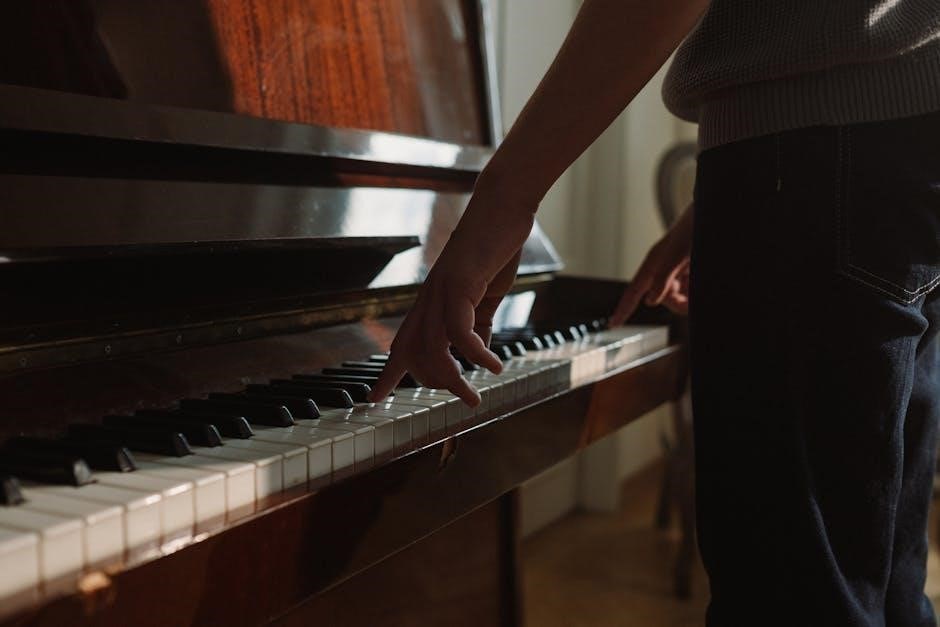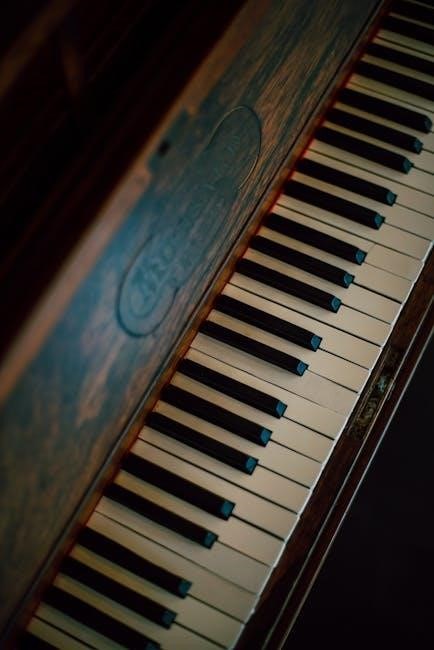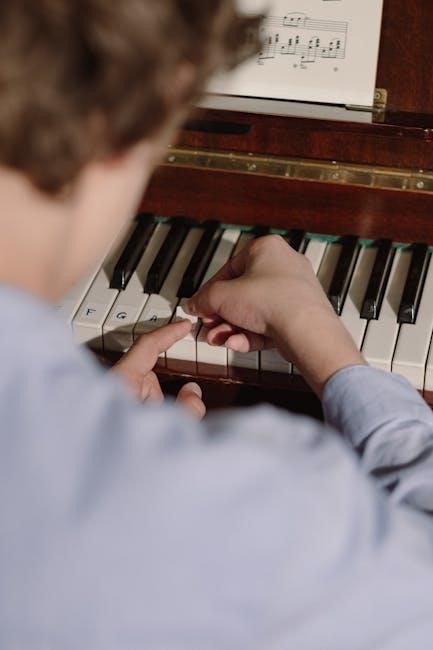let it be chords piano pdf
Overview of “Let It Be” Piano Chords
“Let It Be,” a timeless classic by The Beatles, is beloved for its simplicity and message. This section offers a comprehensive look at piano chords, providing resources like chord charts, PDFs, and tutorials. It helps musicians learn and play the song.
“Let It Be,” a cornerstone of The Beatles’ discography, resonates deeply with audiences worldwide. Released in 1970, this iconic song is celebrated for its poignant lyrics and simple yet powerful melody. It offers solace and hope during challenging times. This introduction aims to provide a gateway for piano enthusiasts to explore the beauty of “Let It Be” through its chords.
Learning to play “Let It Be” on the piano is an enriching experience, suitable for both beginners and experienced musicians. The song’s accessible chord progression allows learners to grasp fundamental piano techniques while connecting with a timeless piece of musical history. Understanding the context and emotional depth of “Let It Be” enhances the playing experience, transforming it from a technical exercise into a heartfelt expression. The song’s message of acceptance and resilience makes it a meaningful addition to any pianist’s repertoire, providing comfort and inspiration with every note played.
Brief History and Significance
“Let It Be” emerged during a tumultuous period for The Beatles, amidst creative differences and internal strife. Penned primarily by Paul McCartney, the song was inspired by a dream he had about his mother, Mary, who had passed away when he was young. In the dream, she offered words of comfort and guidance, which translated into the song’s iconic refrain, “Let it be.”
Released as a single and later as the title track of their final studio album, “Let It Be” quickly became an anthem of hope and perseverance. Its message of finding peace in acceptance resonated deeply with audiences worldwide, solidifying its place in music history. The song’s simplicity and universality have made it a favorite for generations, transcending cultural boundaries and continuing to inspire listeners today. “Let It Be” remains a testament to The Beatles’ enduring legacy and their ability to capture the human experience through music. Its significance lies not only in its historical context but also in its timeless message of hope and resilience.

Understanding the Chords
Delve into the chord structure of “Let It Be,” focusing on its simplicity. We will break down the basic chords used, like C, G, Am, and F. This section provides the foundation for playing the song.
Basic Chords Used (C, G, Am, F)
“Let It Be” relies on a foundation of four fundamental chords: C major, G major, A minor, and F major. These chords create the song’s iconic and comforting sound. Understanding these building blocks is crucial for any pianist aiming to play this song.
The C major chord provides a bright and stable tonal center. The G major adds a touch of resolution and uplift. The A minor introduces a hint of melancholy. Finally, the F major offers warmth and support. These chords work together to create the harmonic progression of “Let It Be.”
Mastering these chords is more than just learning finger positions. It’s about feeling the emotion they convey. Practice transitioning smoothly between them to capture the essence of the song. Beginners should focus on clean and accurate finger placement for optimal sound. With these chords, anyone can begin their journey to playing “Let It Be.”
Chord Progressions in Verse and Chorus
The chord progressions in “Let It Be” are simple yet powerful, distinguishing the verse from the chorus. The verse primarily follows a C-G-Am-F sequence, creating a gentle, reflective mood. This progression supports the lyrical content of finding solace in times of trouble, evoking a sense of introspection and hope.
In contrast, the chorus offers a slight variation that amplifies the emotional impact. It often moves to Am-G-F-C, emphasizing the “Let It Be” message. This shift provides a lift, reinforcing the song’s theme of acceptance and resilience. Understanding these chord progressions is key to accurately playing the song.
Pay close attention to the transitions between these sections. Practice the changes smoothly, maintaining a consistent rhythm and tempo. By understanding the chord progressions, pianists can effectively convey the emotions embedded in “Let It Be.” This knowledge allows for a more nuanced and heartfelt performance.

Piano Tutorials and PDF Resources
Discover valuable piano tutorials and PDF resources to master “Let It Be.” Find accurate online chord charts for learning. Download and print PDF sheet music for convenient practice. These materials support piano players in their musical journey.
Finding Accurate Chord Charts Online
Locating accurate chord charts for “Let It Be” online is crucial for learning the song correctly. Many websites offer chord charts, but their accuracy varies. Look for reputable sources, such as websites dedicated to music education or those affiliated with music publishers. These sites often have professionally transcribed chords.
Check user reviews and ratings to gauge the reliability of a chord chart. If multiple sources present the same chords, it increases the likelihood of accuracy; Be wary of charts that seem overly simplified or contain unusual chord voicings.
Some websites offer interactive chord charts that allow you to transpose the song into different keys. This can be helpful if you want to play the song in a key that better suits your vocal range. Additionally, look for charts that include lyrics, which can assist in following the song’s structure.
Consider using websites that provide chord diagrams for piano, showing the exact finger placement for each chord. This can be especially useful for beginners who are still learning basic chords. By carefully evaluating the available resources, you can find accurate chord charts.
Downloading and Printing PDF Sheet Music
Downloading and printing PDF sheet music for “Let It Be” is a convenient way to have a physical copy of the song’s chords and lyrics. Many websites offer free or paid PDF downloads of sheet music. When searching for PDF sheet music, ensure the source is reputable to avoid low-quality or inaccurate transcriptions.
Before downloading, preview the PDF to confirm it includes all the necessary information, such as chords, lyrics, and song structure. Look for sheet music that is clearly formatted and easy to read, with legible chord symbols and lyrics.
Once you’ve downloaded the PDF, you can print it using a standard printer. Consider using high-quality paper to ensure the sheet music is durable and easy to handle. If you plan to use the sheet music frequently, laminating it can protect it from wear and tear.
Alternatively, you can import the PDF into a tablet or e-reader for a digital sheet music experience. This allows you to easily annotate the sheet music and carry multiple songs with you. Ensure your device has a screen size that is comfortable for reading sheet music.

Tips for Playing “Let It Be” on Piano

Mastering “Let It Be” on piano involves practice and understanding the song’s structure. Beginners can start with simplified arrangements, while experienced players can add embellishments. Focus on smooth transitions and dynamics to capture the song’s emotional depth.
Simplified Arrangements for Beginners
For piano beginners eager to play “Let It Be,” simplified arrangements offer an accessible entry point. These versions often focus on the essential chords: C, G, Am, and F. Mastering these basic chords is crucial before tackling more complex arrangements. Simplified versions typically reduce the number of chord changes and eliminate intricate rhythms.
Online resources, including chord charts and PDF sheet music, provide excellent starting points. These resources often include diagrams illustrating the finger positions for each chord, making it easier for beginners to learn. Additionally, many tutorials offer step-by-step guidance, breaking down the song into manageable sections.
Focusing on consistent rhythm and smooth transitions between chords is key. Practicing slowly and gradually increasing tempo will improve accuracy and fluidity. Consider using a metronome to develop a steady beat. Simplified arrangements allow beginners to experience the joy of playing “Let It Be” while building a solid foundation in piano skills. Remember, patience and persistence are essential for progress.
Adding Embellishments and Variations
Once comfortable with the basic chords of “Let It Be,” pianists can enhance their performance by adding embellishments and variations. These additions can range from simple melodic fills to more complex chord voicings, injecting personal flair into the song. One common embellishment is adding passing tones between chords, creating a smoother, more lyrical sound.
Experimenting with different inversions of the chords can also add depth and interest. For instance, instead of always playing C in root position, try using the first or second inversion. Another technique involves incorporating arpeggios or broken chords, where the notes of the chord are played individually rather than simultaneously.
Varying the dynamics and articulation can further enhance the emotional impact of the song. Try playing certain sections softly and others with more intensity. Staccato and legato articulations can also add contrast. Additionally, consider adding a simple piano riff during instrumental breaks. These embellishments should complement the melody and lyrics, enhancing the overall musical experience.
